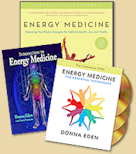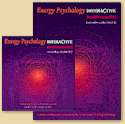![]() The Energy Medicine Handout Bank
The Energy Medicine Handout Bank ![]() About the Bank Featured Articles Latest Articles All Articles
About the Bank Featured Articles Latest Articles All Articles ![]()
Energy Medicine
Case Histories
Innersource
![]()
Health Q & A’s
from an
Energy Medicine
Perspective
![]()
View Free Issues
Energy Community Report
![]()
Download the First
Energy Medicine
Newsletter
![]()
 Energy Medicine Books & Videos
Energy Medicine Books & Videos
Innersource ![]()
Energy Medicine
Foundation Classes
Innersource
Program Details
![]()
Energy Medicine
Certification Program
Innersource
![]()
Energy Medicine
Practitioners
Innersource
![]()
Other Energy
Medicine Resources
Energy Medicine Directory
![]()
Energy Psychology
An Exciting New
Specialty within
Energy Medicine
 Energy Psychology
Energy Psychology
Books & Videos ![]()
EMI Activities
in Behalf of
Energy Psychology
![]()
Energy Medicine
A Career
for the Future
![]()
Contribute
to The Energy Medicine Institute
Practitioner Impressions of Energy Psychology Effectiveness by Diagnostic Category David Feinstein, Ph.D.
Eighteen clinicians who were identified as leaders in energy psychology (EP) within the United States and Canada (based on criteria that included publications on the topic, faculty positions in established training programs, and visibility at national and international conferences), and who are also trained in conventional therapies, offered their impressions of the diagnostic categories where EP was more effective, about as effective, or less effective than the other modalities available to them. The survey used a subset of the diagnostic categories specified in an earlier report of therapist impressions at 11 clinics in Argentina and Uruguay (Andrade & Feinstein, 2004) and produced parallel findings.
The therapists in both groups all believed that EP was more effective than the other approaches available to them in treating most anxiety disorders, including the hyperarousal found in PTSD, and many of the most common emotional difficulties of everyday life, from inappropriate anger to excessive feelings of guilt, shame, grief, jealousy, rejection, and isolation. Conditions for which combining EP with more conventional treatments was believed to produce more rapid outcomes than the conventional treatment alone included mild to moderate reactive depression, generalized anxiety disorder, obsessive-compulsive disorders, learning skills disorders, borderline personality disorder, eating disorders, and substance abuse. Most therapists in the two groups reported that as the sole therapy, they believed EPs effectiveness is limited in overcoming major endogenous depression, dissociative identity disorder, bipolar disorders, many personality disorders, and psychotic disorders, although several described some success in treating such disorders (including the resolution of trauma underlying dissociative identity disorder and the reduction of auditory and visual hallucinations with psychotic disorders). Several also mentioned that while they did not see EP as an independent treatment for these disorders, it had helped individuals with debilitating psychiatric conditions make better adjustments to their diagnosis and their life situation, in part by reducing the stress associated with the primary condition.
The only harm reported, in responses by the second group to a query about contraindications, was that in the hands of inexperienced or lay therapists, people have sometimes been retraumatizednot by the technique itself, but by revisiting unresolved trauma without adequate preparation or support. Practitioners trained first in EMDR and then in EP also reported that EP both provides greater flexibility in the range of issues that can be addressed and that its methods can be more readily modulated by the practitioner to prevent retraumatization, an issue that has been of concern with EMDR treatments (Hartung & Galvin, 2003). Concern about using tapping methods with individuals who have convulsive disorders was mentioned by one respondent, although no instances of harm were described. While these reports originate from therapists who are professionally identified with EP, they provide initial practitioner impressions of the conditions for which EP is more effective and less effective, and they suggest that the method is unlikely to do harm.
References
Andrade, J., & Feinstein, D. (2004). Energy psychology: Theory, indications, evidence. In D. Feinstein, Energy psychology interactive (Appendix, pp.199 214). Ashland, OR: Innersource.
Hartung, J., and Galvin, M. (2003). Energy psychology and EMDR: Combining forces to optimize treatment. New York: Norton.
Home Handout Bank Energy Medicine Q & A’s Energy Community Report
Contribute to the Energy Medicine Institute Energy Psychology
The Energy Medicine Institute
777 East Main Street – Ashland, OR 97520
(541) 482-1800
* ]]> *
www.energymed.org
Design, Development, Hosting, and Maintenance by The CyberSide & Co.
All contents copyright © The Energy Medicine Institute, 2001-2017. All rights reserved.


